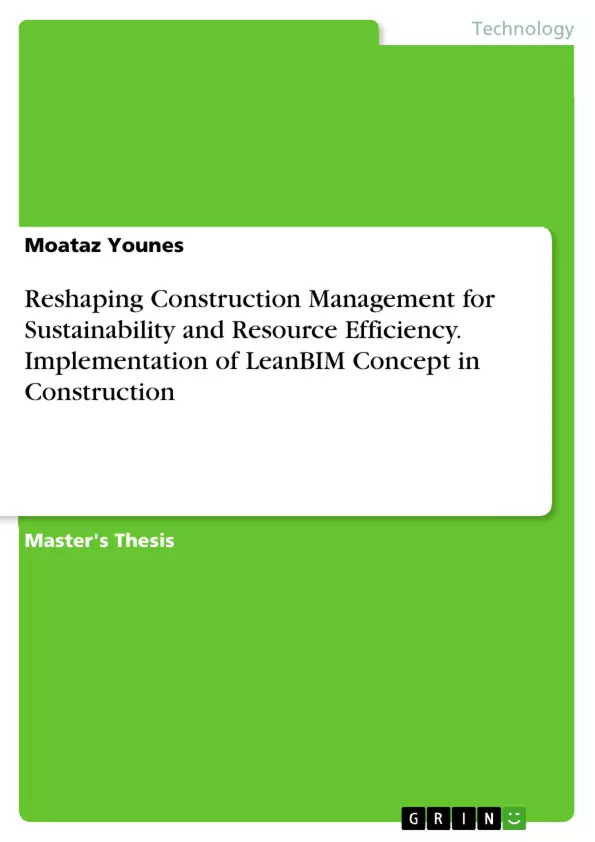Construction is considered to be a high waste generating industry, in spite of its importance for human lives and economies. A lot of researches have been conducted to find out new ways to improve the way construction projects are managed. The main goals of these researches were to reduce the cost and time for projects as well as increase the quality of the final product.
In 1990’s Lean Construction concept has been founded as an alternative for the conventional construction project management methodologies, based on Lean manufacturing concepts focusing on value and reducing waste in the construction processes.
Building Information Modeling (BIM) is a modern tool enabling intelligent model based process. BIM implementation has a lot of benefits to the construction, for instance, making use of visualization of the final product to facilitate communication between different disciplines and team members, enable what-if analysis and analyze the constructability of a building.
During the last decade, Pioneering contractors in US have realized the synergic fit between Lean and BIM. The interaction between Lean Construction and BIM has been the topic of many researches since then.
This research introduces the term “LeanBIM”, which refers to the combination of the tools of Lean and BIM, and discuss their effects on sustainability and resource efficiency. An extensive review of literature is carried out and a survey is conducted on the Lean and BIM professionals and researchers from all over the world. The results showed the positive effect of LeanBIM implementation on sustainability of building as well as resource efficiency. LeanBIM is also expected to reduce the overall cost and time required for construction, and increase the quality. The results also showed that there is shortage in Lean/BIM professionals, lack of legal framework to enable the collaboration between all parties, lack of awareness of LeanBIM benefits. It is observed from the result that a considerable investment is required to form an IT infrastructure capable of implementing LeanBIM.
Keywords: Lean Construction, Building Information Modeling, Sustainability, LeanBIM, Resource efficiency, Construction Project Management.
Inhaltsverzeichnis (Table of Contents)
- Introduction
- Literature Review
- Lean Construction
- Building Information Modeling (BIM)
- The Synergy Between Lean Construction and BIM
- Methodology
- Research Design
- Data Collection Methods
- Data Analysis Methods
- Findings and Discussion
- The Impact of LeanBIM on Sustainability
- The Impact of LeanBIM on Resource Efficiency
- Challenges and Opportunities in Implementing LeanBIM
- Conclusion
- Recommendations
- References
Zielsetzung und Themenschwerpunkte (Objectives and Key Themes)
This research aims to investigate the combined effects of Lean Construction and BIM (termed "LeanBIM") on sustainability and resource efficiency in the construction industry. By exploring the synergy between these two approaches, the study seeks to identify potential benefits and challenges associated with LeanBIM implementation.
- Impact of LeanBIM on Sustainability
- Impact of LeanBIM on Resource Efficiency
- Benefits and Challenges of LeanBIM Implementation
- Role of LeanBIM in Enhancing Construction Project Management
- Potential for LeanBIM to Reduce Waste and Improve Quality
Zusammenfassung der Kapitel (Chapter Summaries)
The research begins by reviewing the existing literature on Lean Construction and BIM, focusing on their individual benefits and the potential for synergy. The study then outlines the research methodology, including the data collection and analysis methods employed. The findings and discussion section explores the specific impacts of LeanBIM on sustainability and resource efficiency, highlighting key benefits and challenges. The conclusion summarizes the research findings and offers recommendations for future implementation of LeanBIM.
Schlüsselwörter (Keywords)
The research centers around the key concepts of Lean Construction, Building Information Modeling (BIM), sustainability, resource efficiency, and LeanBIM. It also explores the role of LeanBIM in improving construction project management and reducing waste in the industry.
- Citar trabajo
- Moataz Younes (Autor), 2015, Reshaping Construction Management for Sustainability and Resource Efficiency. Implementation of LeanBIM Concept in Construction, Múnich, GRIN Verlag, https://www.grin.com/document/307895



